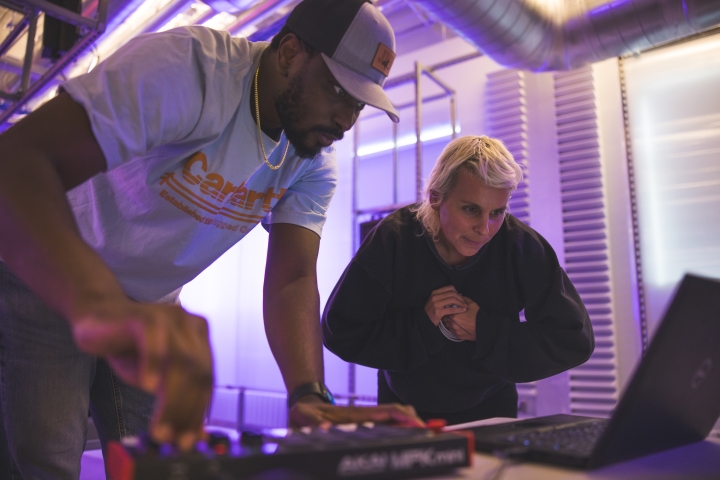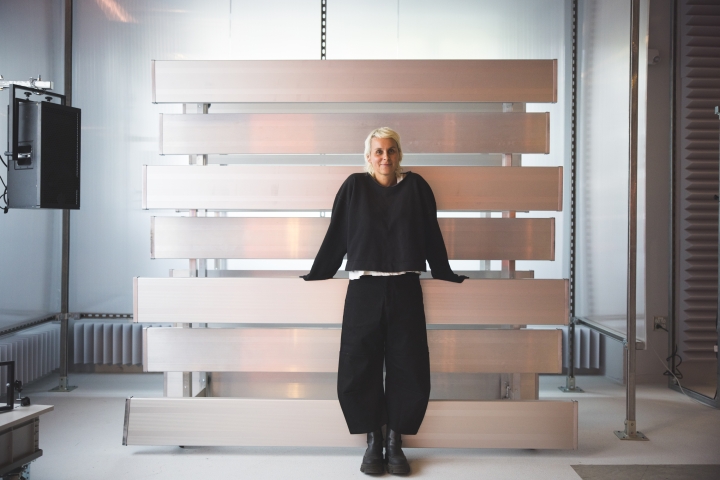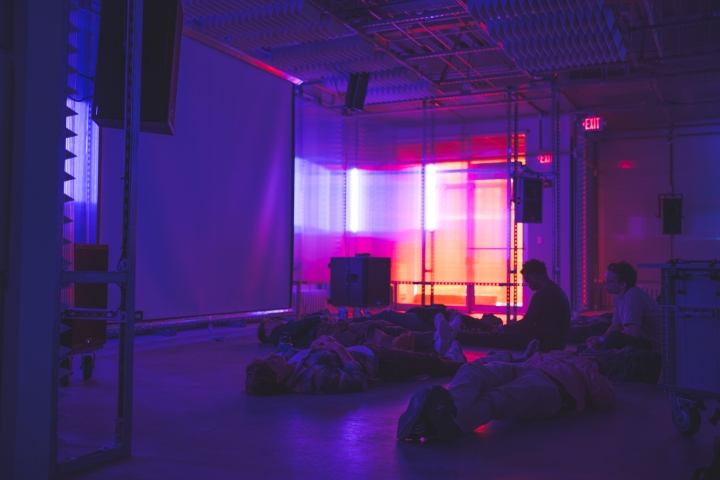Dartmouth’s first master of fine arts program is giving composers, artists, and scholars three years to mine the power of sound, and a new, custom-built studio in which to do it.
Guarini School of Graduate and Advanced Studies Dean Jon Kull ’88 says the new MFA in Sonic Practice exemplifies Dartmouth’s dedication to cutting-edge arts and interdisciplinary scholarship.
“This program allows students to deeply explore sound as a creative and cultural force, reflecting Dartmouth’s commitment to innovation and expanding its academic reach,” Kull says.
Directed by groundbreaking composer Ash Fure, the three-year program replaced the two-year master of arts degree in digital musics, effective June 1. Like its predecessor, the MFA is fully funded, providing tuition coverage and a stipend to students working extensively with sound.
The Warehouse, a laboratory for sonic art and key anchor in the MFA program, opened in September at 4 Currier Street. The 2,500-square-foot room functions as a classroom for graduate and undergraduate level courses, a performance space, and a spatial sound lab for faculty and students.
The project, launched by Fure and designed by her close architectural collaborators TEAM, whose leaders include Fure’s brother, architect Adam Fure, and stock-a-studio, has been in the works since 2021. It has received funding from the President’s Office, the Dean of Faculty of Arts and Sciences, Office of the Provost, Guarini, and the Department of Music.
Fure describes The Warehouse as a playground for artists working with sound and light.
“I think of sound as a sensory and social technology that works on the body and the body politic,” says Fure, an associate professor of sonic arts who has won two Lincoln Center Awards for Emerging Artists, a Guggenheim Fellowship, and a Fulbright Fellowship, among other awards. “My hope is that The Warehouse helps open people up to the visceral richness of sonic experience and the simple, profound power of listening together in our fractured age.”
MFA is a ‘game changer’
The digital musics program was originally conceived to facilitate an experimental research phase for students on the way to a PhD program or to industry, but in recent years, that focus has shifted to creative practice, says Fure, who earlier this fall performed her piece ANIMAL at two prominent contemporary music festivals—the Venice Biennale of Music in Italy and Unsound in Krakow, Poland.
Given the transformation, two years for the program felt too short.

“Students would come in, crack open artistically, and have to quickly turn those pieces into this polished thesis,” Fure says. The new, third year is “a game changer” for students “who now have time to develop a robust portfolio and build momentum and clarity around their practice.”
Those who were already in the digital musics program were given the option of staying on to complete the MFA; they all did, including Mac Waters, a sound artist who works in a variety of interdisciplinary contexts.
The opportunity is “mind-blowing,” says Waters, whose thesis will blend music, medieval poetry, and virtual reality technology to form a group video game concert.
“This is a terminal degree. You can teach at the college level with this degree,” he says. And as an artist, he is “extremely grateful” to have another year to develop his own creative practice and projects.
‘Wildly different sonic inclinations’
Focused mentorship, critical engagement, and community support are among the main components of the MFA program, which welcomes a wide range of aesthetic approaches and creative lineages.
“One hallmark of the MFA is that we’re embracing a really expansive notion of what it means to work with sound as a material,” Fure says.
Sonic Practice faculty member César Alvarez notes that in their earliest conversations about the MFA program, both they and Fure—composers who have spent their careers “navigating wildernesses between many types of creative practices and landscapes,” were trying to dream up a program that would have served them both, despite their distinct creative approaches.
“I’m absolutely enthralled by this grad program and the way that it has created a space for so much rigor and artistic freedom alongside unparalleled resources,” says Alvarez, an assistant professor of music whose accolades include the Jonathan Larson Award, the Kleban Prize, and a Guggenheim Fellowship. “I would have been so motivated to go to this program as a young artist, and now as a professor I get to spend time inside of such a rich creative environment.”
“I am really proud that we’ve created an MFA program that stands alone in our field as a space for composers to define themselves according to their wildest and most unusual ideas,” Alvarez adds.
Students are invited to imagine who they want to be in conversation with, to identify the “thinkers and makers and sounders” who have a sense of kinship with some of the primary curiosities that are driving their practice, Fure says. In turn, faculty members help students stretch their practice “toward whatever horizon is most compelling to them.”
That’s been important to Waters, who describes sonic practice as a “choose-your-own adventure kind of world” encompassing pop music production, symphony orchestra concerts, field recordings, “and everything beyond and in between.”
“It’s great to not have to feel pushed or pulled into a certain aesthetic box or creative box,” he says.
Like many of his classmates, Waters has worked with several Sonic Practice faculty members, a cohort of award-winning composers, researchers, and performers who, in addition to Fure and Alvarez, include Bethany Younge, technical director and lecturer; Samita Sinha, a lecturer; and affiliate faculty members Taylor Ho Bynum, director of Coast Jazz Orchestra at Dartmouth, and Allie Martin, assistant professor of music and director of the Black Sound Lab.
“The thing that’s so great is that all of those people have wildly different practices, wildly different aesthetic interests, wildly different sonic inclinations,” Waters says. “I admire all of their work so much, and the way that they navigate this weird hybrid industry and how they champion their own work and use it as a teaching tool.”
An annual retreat, weekly group critiques over lunch, and a collaborative approach to creating have helped forge connections students say are vital to the program.
“We’re all focused on developing work that is not necessarily seen as popular or mainstream, and our professors are helping us honor the truth within our art-making process, as opposed to leaning on more conventional structures,” says Charles Peoples III, an MFA student who performed last spring at Dartmouth’s New Music Festival. “It’s a really challenging process and a lot of emotions come up. I think one of the goals of the program is to create a supportive container for that experimental and growth process for each of us.”
A ‘genre-flexible’ studio
The Warehouse, a spacious room with concrete floors, is located at the end of a hallway on the first floor of 4 Currier. The powerful multichannel audio system includes 24 speakers and two subwoofers, each of which can be individually controlled. With its silver-colored interior, wheeled lightweight furniture, and customizable sound and lighting systems, the space is designed to be “mutable and alive,” Fure says.
The design includes a steel structural system that provides rigging points for materials such as speakers and lights, allowing artists to “play” the architecture as they would an instrument, according to a news release from stock-a-studio, and TEAM. It also leaves visible often-hidden architectural infrastructure, from ducts, pipes, and wires to speakers and cables and elements of the lighting system, which become “a visual performance in themselves.”

“We wanted the room to feel genre-flexible, like it could host a banging dance party but also an intricate spatial audio concert, and be in visual conversation with club culture as much as with institutional spatial audio centers,” Fure says. “Because of the flexibility of the design, we have a chance to really play with how each listening condition is structured, and consider that—how we gather in sound—as part of the experimental field.”
That versatility was on display in a recent meeting of Fure’s class Music 26/Sonic Arts II: Sound is Alive, which aims to help students expand their technical and creative capabilities and their aesthetic imaginations, in part through exposure to the work of contemporary sound artists.
Anh-Ton Nguyen ’26 presented a composition he created using Ableton Live, the digital audio workstation used most often in Dartmouth’s sonic arts classes. Nguyen described his project, which employs harmonic components, drum beats, and syncopation to create evolving patterns. As he spoke, the biology major referred to the electronic mixing board, which was projected onto a screen in front of the class. His classmates and Fure asked questions and offered feedback before closing out the discussion with applause.
Toward the end of class, Fure set up a mini listening party, cueing a modular synth track by Alessandro Cortini, a solo artist and former touring member of Nine Inch Nails. Fure dimmed the overhead lights and turned on lamps that glowed purple and orange. The students sat or lay on the floor, in order to feel the vibrations from the sound, and Fure offered a listening prompt.
The Cortini track, Prima Emosfera, which was created with a synthesizer, “doesn’t have harmony or melody in the traditional way you think of it,” Fure said. “What do we listen for when those are removed? How does it hit your body, your mind?”
Afterward, seated in a circle on the floor with Fure, the students shared their impressions of the work, one of several they had studied that week.
Christian Smith ’27 said that at first he didn’t know how to listen to the song, but after hearing it a half dozen times, that was no longer the case.
“Now it has a very clear structure,” starting off calm and peaceful, changing as harmonic tension builds and finally peaks, Smith said. It’s “intentionally meditative.”
Building a culture of listening
The class had technical assistance from teaching assistant Raegan Padula ’24, who after completing her undergraduate degree in music became the music department’s first post-baccalaureate intern. In addition to working as a TA and developing her own projects, Padula will also beta test listening sessions in the studio.
The goal is to eventually host public events “to promote more active listening and togetherness through sound locally,” providing a taste of the listening culture that exists in bars and other venues in cities such as Berlin and New York, Padula says.
She’s excited about the current surge of experimental musical thinkers and activity in Hanover, says Padula, a composer and instrumentalist whose fascination with sonic arts dates back to a class she took with Fure as a first-year student.
“I feel like I’m here at just the right time,” she says. “There are a lot of exciting new things happening, and I feel very lucky to be here for it.”
Applications for the MFA program are currently being accepted for the 2025-26 academic year.
